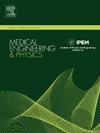Effect of uncertainties in musculoskeletal modeling inputs on sensitivity of knee joint finite element simulations
IF 1.7
4区 医学
Q3 ENGINEERING, BIOMEDICAL
引用次数: 0
Abstract
Musculoskeletal finite element modeling is used to estimate mechanical responses of knee joint tissues but involves uncertainties in muscle activations, marker locations, cartilage stiffness, maximum isometric forces, and gait parameter personalization. This study investigates how these uncertainties affect cartilage mechanical responses in knee joint finite element models during walking. We selected three subjects and constructed five musculoskeletal models for each, representing different variations of modeling assumptions, along with a reference model using conventional assumptions. We then ran finite element simulations of knee joints using both personalized gait inputs (motion and loading boundary conditions) and non-personalized gait inputs from literature. Our results demonstrated that varying modeling assumptions, such as optimization function for muscle activation patterns, knee marker position, knee cartilage stiffness, and maximum isometric force, produced highly subject-specific effects. Differences between the reference and altered models ranged from 3% to 30% in musculoskeletal modeling and from 1% to 61% in finite element modeling results. The largest effects occurred with non-personalized gait data, resulting in up to 6- and 2-fold changes in musculoskeletal and finite element modeling results, respectively. This study highlights the sensitivity of knee mechanics to different modeling assumptions and underscores the importance of applying personalized gait parameters for accurate finite element simulations.
肌肉骨骼建模输入的不确定性对膝关节有限元模拟灵敏度的影响
肌肉骨骼有限元建模用于估计膝关节组织的机械反应,但涉及肌肉激活,标记位置,软骨刚度,最大等距力和步态参数个性化的不确定性。本研究探讨了这些不确定性如何影响膝关节有限元模型在行走过程中的软骨力学反应。我们选择了三个受试者,并为每个受试者构建了五个肌肉骨骼模型,代表了建模假设的不同变化,以及使用常规假设的参考模型。然后,我们使用个性化步态输入(运动和负载边界条件)和非个性化步态输入(来自文献)对膝关节进行有限元模拟。我们的研究结果表明,不同的建模假设,如肌肉激活模式的优化函数、膝关节标记位置、膝关节软骨刚度和最大等距力,会产生高度的受试者特异性效果。参考模型和修改模型在肌肉骨骼建模结果上的差异在3%到30%之间,在有限元建模结果上的差异在1%到61%之间。非个性化步态数据的影响最大,分别导致肌肉骨骼和有限元建模结果的6倍和2倍变化。本研究强调了膝关节力学对不同建模假设的敏感性,并强调了应用个性化步态参数进行精确有限元模拟的重要性。
本文章由计算机程序翻译,如有差异,请以英文原文为准。
求助全文
约1分钟内获得全文
求助全文
来源期刊

Medical Engineering & Physics
工程技术-工程:生物医学
CiteScore
4.30
自引率
4.50%
发文量
172
审稿时长
3.0 months
期刊介绍:
Medical Engineering & Physics provides a forum for the publication of the latest developments in biomedical engineering, and reflects the essential multidisciplinary nature of the subject. The journal publishes in-depth critical reviews, scientific papers and technical notes. Our focus encompasses the application of the basic principles of physics and engineering to the development of medical devices and technology, with the ultimate aim of producing improvements in the quality of health care.Topics covered include biomechanics, biomaterials, mechanobiology, rehabilitation engineering, biomedical signal processing and medical device development. Medical Engineering & Physics aims to keep both engineers and clinicians abreast of the latest applications of technology to health care.
 求助内容:
求助内容: 应助结果提醒方式:
应助结果提醒方式:


